The Effects of Long-Acting Water Erosion on the Hydro-Pedological Characteristics of Chernozems
Abstract
1. Introduction
2. Material and Methods
2.1. Study Area
2.2. Methods
2.3. Material
3. Results
3.1. Monitoring Infiltration Characteristics
3.2. Evaluation of Physical Properties
4. Discussion
5. Conclusions
Author Contributions
Funding
Institutional Review Board Statement
Informed Consent Statement
Data Availability Statement
Conflicts of Interest
References
- Robinson, D.A.; Hockley, N.; Dominati, E.; Lebron, I.; Scow, K.M.; Reynolds, B.; Emmett, B.A.; Keith, A.M.; de Jonge, L.W.; Schjonning, P.; et al. Natural capital, ecosystem services, and soil change: Why soil science must embrace an ecosystems approach. Vadose Zone J. 2012, 11, 6. [Google Scholar] [CrossRef]
- Naveen, K.; Subhas, C.; Pathak, H.; Aggarwal, P.K.; Gupta, N.C.; Mukesh, S.; Debashis, C. Impacts of climate change on Agriculture. Outlook Agric. 2007, 36, 109–118. [Google Scholar]
- Trnka, M.; Semerádová, D.; Novotný, I.; Dumbrovský, M.; Drbal, M.K.; Pavlík, F.; Vopravil, J.; Štěpánková, P.; Vizina, A.; Balek, J.; et al. Assessing the combined hazards of drought, soil erosion and local flooding on agricultural land: A Czech case study. Clim. Res. 2016, 70, 231–249. [Google Scholar] [CrossRef]
- Kiryluk, A. Changes in Technologies Soil and Plant Cultivation in the Province Podlaskie and Their Impact on Environment. Ekon. Srodowisko-Econ. Environ. 2016, 2, 287–301. [Google Scholar]
- Bíla, P.; Šarapatka, B.; Horňák, O.; Novotná, J.; Brtnický, M. Which quality indicators reflect the most sensitive changes in the soil properties of the surface horizons affected by the erosion processes? Soil Water Res. 2020, 15, 116–124. [Google Scholar] [CrossRef]
- Panagos, P.; Borrelli, P.; Poesen, J.; Ballabio, C.; Lugato, E.; Meusburge, K.; Montanarella, L.; Alewell, C. The new assessment of soil loss by water erosion in Europe. Environ. Sci. Policy 2015, 54, 438–447. [Google Scholar] [CrossRef]
- Barancikova, G.; Madaras, M. Attempt to assessment of non-production soil functions-filtration of organic contaminants. Int. J. Ecol. Probl. Biosph. 2003, 22, 323–336. [Google Scholar]
- Humann, M.; Schuler, G.; Muller, C.; Schneider, R.; Johst, M.; Caspari, T. Identification of runoff processes-The impact of different forest types and soil properties on runoff formation and floods. J. Hydrol. 2011, 409, 637–649. [Google Scholar] [CrossRef]
- Geroy, I.J.; Gribb, M.M.; Marshall, H.P.; Chandler, D.G.; Benner, S.G.; McNamara, J.P. Aspect influences on soil water retention and storage. Hydrol. Process. 2011, 25, 3836–3842. [Google Scholar] [CrossRef]
- Dumbrovský, M.; Sobotková, V.; Šarapatka, B.; Váchalová, R.; Pavelková Chmelová, R.; Váchal, J. Long-term improvement in surface water quality after land consolidation in a drinking water reservoir catchment. Soil Water Res. 2015, 10, 49–55. [Google Scholar] [CrossRef]
- Nagy, G.; Lóczy, D.; Czigány, S.; Pirkhoffer, E.; Fábián, S.Á.; Ciglič, R.; Ferk, M. Soil moisture retention on slopes under different agricultural land uses in hilly regions of Southern Transdanubia. Hung. Geogr. Bull. 2020, 69, 263–280. [Google Scholar] [CrossRef]
- Rahmati, M.; Weihermüller, L.; Vanderborght, J.; Pachepsky, Y.A.; Mao, L.; Sadeghi, S.H.; Moosavi, N.; Kheirfam, H.; Montzka, C.; Van Looy, K.; et al. Development and analysis of the Soil Water Infiltration Global database. Earth Syst. Sci. Data 2018, 10, 1237–1263. [Google Scholar] [CrossRef]
- Morbidelli, R.; Corradini, C.; Saltalippi, C.; Flammini, A.; Dari, J.; Govindaraju, R.S. A New Conceptual Model for Slope-Infiltration. Water 2019, 11, 678. [Google Scholar] [CrossRef]
- Bouwer, H. Artificial recharge of groundwater: Hydrogeology and engineering. Hydrogeol. J. 2002, 10, 121–142. [Google Scholar] [CrossRef]
- Parchami-Araghi, F.; Mirlatifi, S.M.; Dashtaki, S.G.; Mahdian, M.H. Point estimation of soil water infiltration process using Artificial Neural Networks for some calcareous soils. J. Hydrol. 2013, 481, 35–47. [Google Scholar] [CrossRef]
- Hillel, D. Introduction to Soil Physics; Academic Press Massachusetts: Cambridge, MA, USA, 1982; Available online: https://books.google.cz/books?id=cfLJCgAAQBAJ&printsec=frontcover&hl=cs&source=gbs_ge_summary_r&cad=0#v=onepage&q&f=false (accessed on 19 October 2022).
- Lal, R.; Shukla, M.K. Principles of Soil Physics; CRC Press: Boca Raton, FL, USA, 2004. [Google Scholar]
- Kutílek, M.; Nielsen, D.R. Soil Hydrology; Catena Verlag: Cremlingen, Germany, 1994; p. 370. [Google Scholar]
- Morbidelli, R.; Saltalippi, C.; Flammini, A.; Cifrodelli, M.; Picciafuoco, T.; Corradini, C.; Govindaraju, R.S. In situ measurements of soil saturated hydraulic conductivity: Assessment of reliability through rainfall-runoff experiments. Hydrol. Process. 2017, 31, 3084–3094. [Google Scholar] [CrossRef]
- Gregorich, E.G.; Carter, M.R. Soil Quality for Crop Production and Ecosystem Health; Elsevier: Amsterdam, The Netherlands, 1997; p. 447. [Google Scholar]
- Otalvaro, I.F.; Neto, M.P.C.; Delage, P.; Caicedo, B. Relationship between soil structure and water retention properties in a residual compacted soil. Eng. Geol. 2016, 205, 73–80. [Google Scholar] [CrossRef]
- Minasny, B.; McBratney, A.B. Limited effect of organic matter on soil available water capacity. Eur. J. Soil Sci. 2017, 69, 39–47. [Google Scholar] [CrossRef]
- Hollis, J.M.; Jones, R.J.A.; Palmer, R.C. The effects of organic matter and particle size on the water-retention properties of some soils in the West Midlands of England. Geoderma 1977, 17, 225–238. [Google Scholar] [CrossRef]
- Kintl, A.; Elbl, J.; Lošák, T.; Vaverková, M.D.; Nedělník, J. Mixed intercropping of wheat and white clover to enhance the sustainability of the conventional cropping system: Effects on biomass production and leaching of mineral nitrogen. Sustainability 2018, 10, 3367. [Google Scholar] [CrossRef]
- Manojlović, M.; Aćìn, V.; Šeremešić, S. Long-term effects of agronomic practices on the soil organic carbon sequestration in Chernozem. Arch. Agron. Soil Sci. 2008, 54, 353–367. [Google Scholar] [CrossRef]
- Mu, W.; Yu, F.; Li, C.; Xie, Y.; Tian, J.; Liu, J.; Zhao, N. Effects of rainfall intensity and slope gradient on runoff and soil moisture content on different growing stages of spring maize. Water 2015, 7, 2990–3008. [Google Scholar] [CrossRef]
- Eurostat. Agriculture, Forestry and Fishery Statistics. 2020 Edition. Available online: https://ec.europa.eu/eurostat/web/agriculture/data/database (accessed on 22 August 2022).
- Sklenička, P.; Šímová, P.; Hrdinová, K.; Salek, M. Changing Rural Landscapes Along the Border of Austria and the Czech Republic Between 1952 and 2009: Roles of Political, Socioeconomic and Environmental Factors. Appl. Geogr. 2014, 47, 89–98. [Google Scholar] [CrossRef]
- Pelíšek, I. Investigation of soil water infiltration at a scale of individual earthworm channels. Soil Water Res. 2018, 13, 1–10. [Google Scholar] [CrossRef]
- Kulhavý, Z.; Kvítek, T. Experience with the use of compact ponding infiltrometer. Vodn. Hospodářství 2010, 6, 179–180. (In Czech) [Google Scholar]
- Kutílek, M. Soil Science in Water Management; SNTL: Baltimore, MD, USA; Praha, Czech Republic, 1978. (In Czech) [Google Scholar]
- Hammerová, A.; Polcar, A.; Šimečková, J.; Jandák, J. Rizika pěstování cukrové řepy na erozně ohrožených pozemcích. Listy Cukrov. Reparske 2016, 132, 375–379. [Google Scholar]
- Suleiman, A.A.; Ritchie, J.T. Estimating Saturated Hydraulic Conductivity from Soil Porosity. Trans. ASAE 2001, 44, 235–339. [Google Scholar] [CrossRef]
- Jarvis, N.; Koestel, J.; Messing, I.; Moeys, J.; Lindahl, A. Influence of soil, land use and climatic factors on the hydraulic conductivity of soil. Hydrol. Earth Syst. Sci. 2013, 17, 5185–5195. [Google Scholar] [CrossRef]
- Nikodem, A.; Kodešová, R.; Fér, M.; Klement, A. Using scaling factors for characterizing spatial and temporal variability of soil hydraulic properties of topsoils in areas heavily affected by soil erosion. J. Hydrol. 2021, 593, 125897. [Google Scholar] [CrossRef]
- McKeague, J.A.; Wang, C.; Topp, G.C. Estimating Saturated Hydraulic Conductivity from Soil Morphology. Soil Sci. Soc. Am. J. 1982, 46, 1239–1244. [Google Scholar] [CrossRef]
- Yang, P.; Dong, W.; Heinen, M.; Qin, W.; Oenema, O. Soil Compaction Prevention, Amelioration and Alleviation Measures Are Effective in Mechanized and Smallholder Agriculture: A Meta-Analysis. Land 2022, 11, 645. [Google Scholar] [CrossRef]
- Martínez, E.; Fuentes, J.P.; Silva, P.; Valle, S.; Acevedo, E. Soil physical properties and wheat root growth as affected by no-tillage and conventional tillage systems in a Mediterranean environment of Chile. Soil Tillage Res. 2008, 99, 232–244. [Google Scholar] [CrossRef]
- Badalíková, B. Influence of Soil Tillage on Soil Compaction. In Soil Engineering; Soil Biology; Dedousis, A., Bartzanas, T., Eds.; Springer: Berlin/Heidelberg, Germany, 2010; Volume 20. [Google Scholar]
- Barik, K.; Aksakal, E.L.; Islam, K.R.; Sari, S.; Angin, I. Spatial variability in soil compaction properties associated with field traffic operations. Catena 2014, 120, 122–133. [Google Scholar] [CrossRef]
- Skaalsveen, K.; Ingram, J.; Clarke, L.E. The effect of no-till farming on the soil functions of water purification and retention in north-western Europe: A literature review. Soil Tillage Res. 2019, 189, 98–109. [Google Scholar] [CrossRef]
- Bradford, J.M.; Huang, C. Interrill soil erosion as affected by tillage and residue cover. Soil Tillage Res. 1994, 31, 353–361. [Google Scholar] [CrossRef]
- Jaksik, O.; Kodesova, R.; Kubis, A.; Stehlikova, I.; Drabek, O.; Kapicka, A. Soil aggregate stability within morphologically diverse areas. CATENA 2015, 127, 287–299. [Google Scholar] [CrossRef]
- Lal, R. Global soil erosion by water and carbon dynamics. In Soils and Global Change, Advances in Soil Science; Lal, R., Kimble, J., Levine, E., Stewart, B.A., Eds.; CRC Press: Boca Raton, FL, USA, 1995; pp. 131–142. [Google Scholar]
- Podhrázská, J.; Kučera, J.; Karásek, P.; Konečná, J. Land degradation by erosion and its economic consequences for the region of South Moravia (Czech Republic). Soil Water Res. 2015, 10, 105–113. [Google Scholar] [CrossRef]
- Vopravil, J.; Formánek, P.; Khel, T. Comparison of the physical properties of soils belonging to different reference soil groups. Soil Water Res. 2021, 16, 29–38. [Google Scholar] [CrossRef]
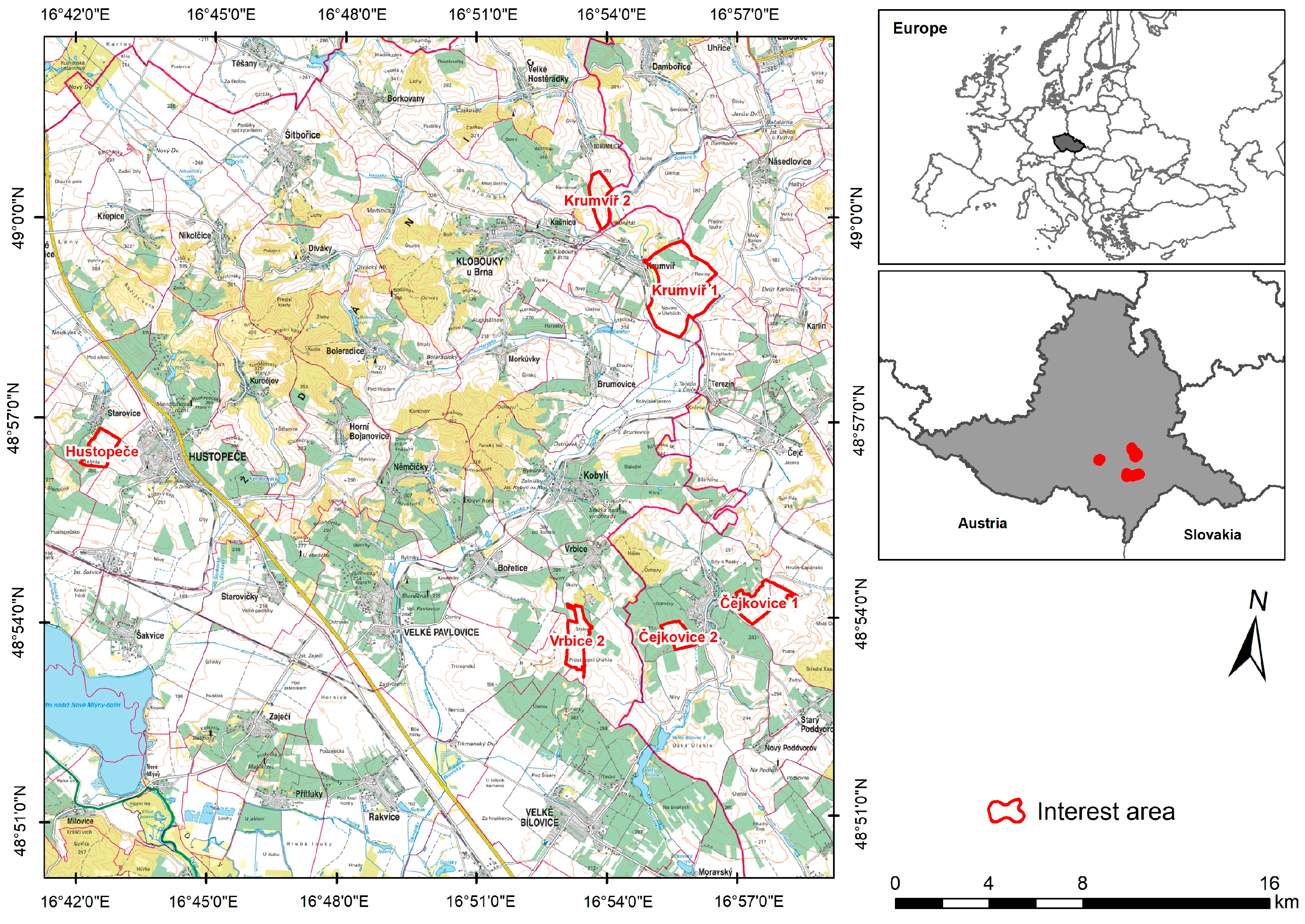
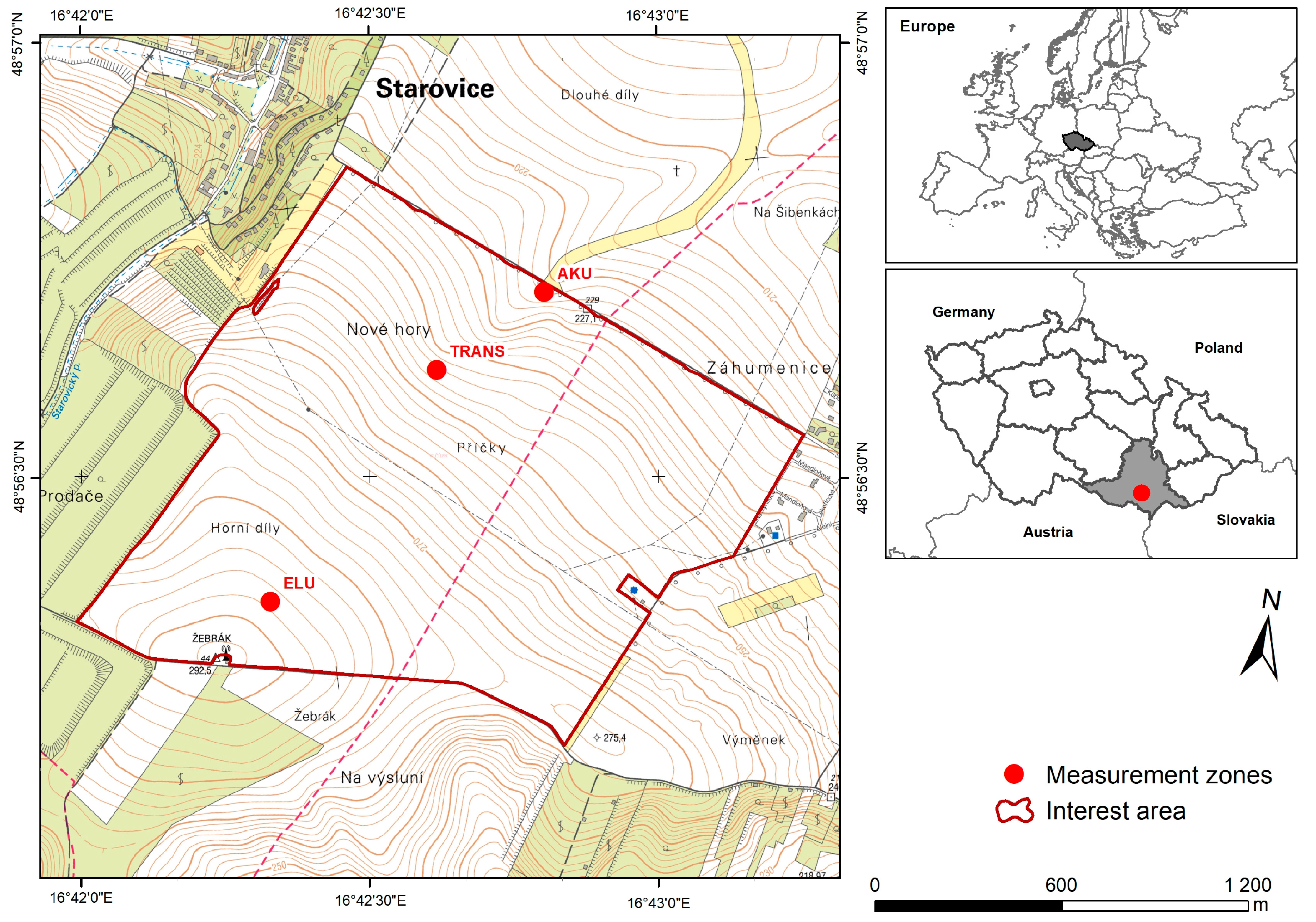
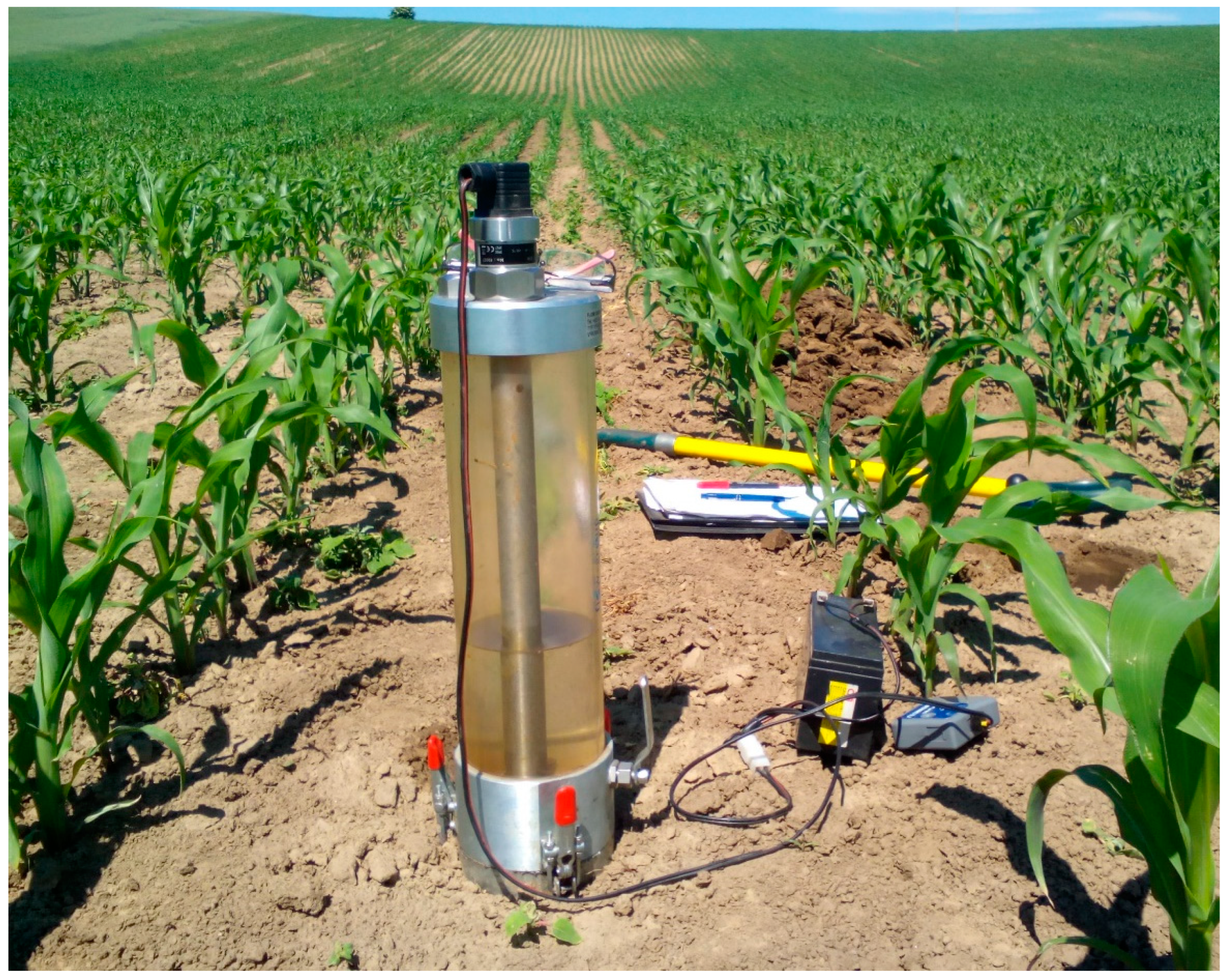
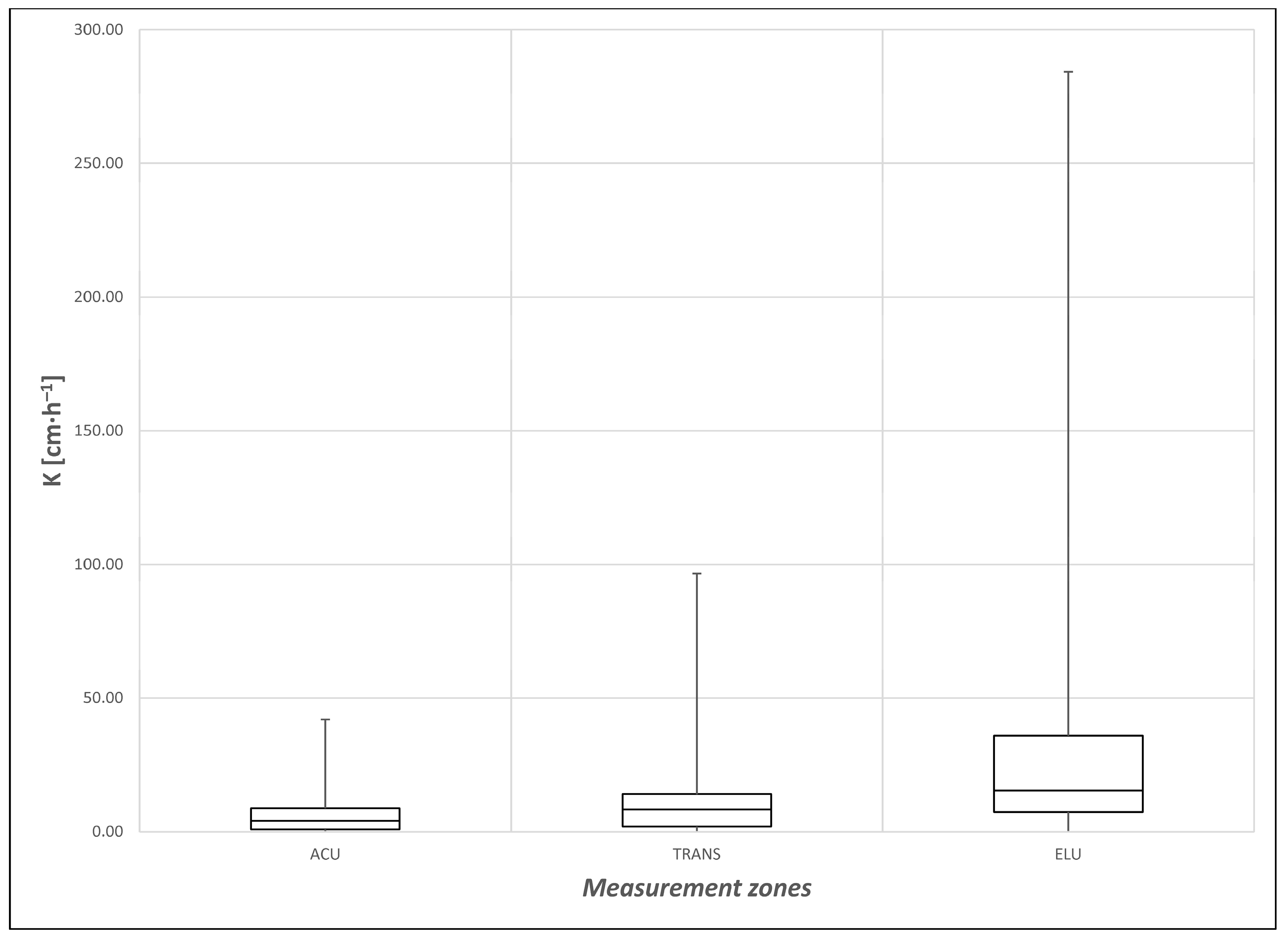
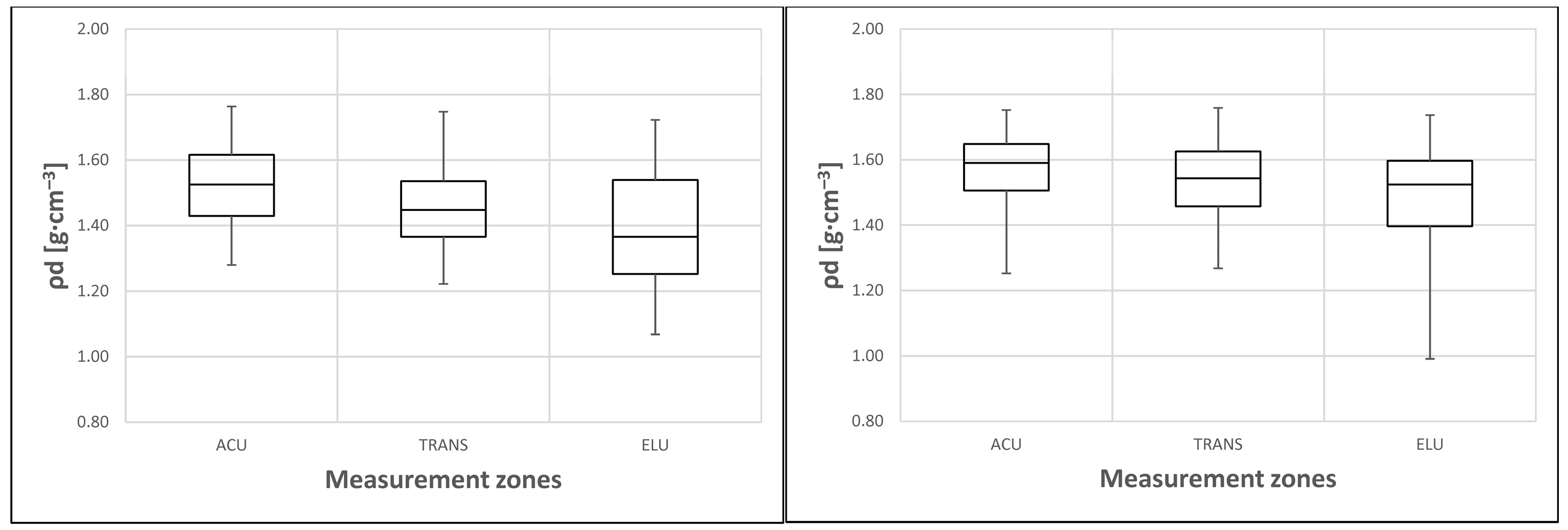
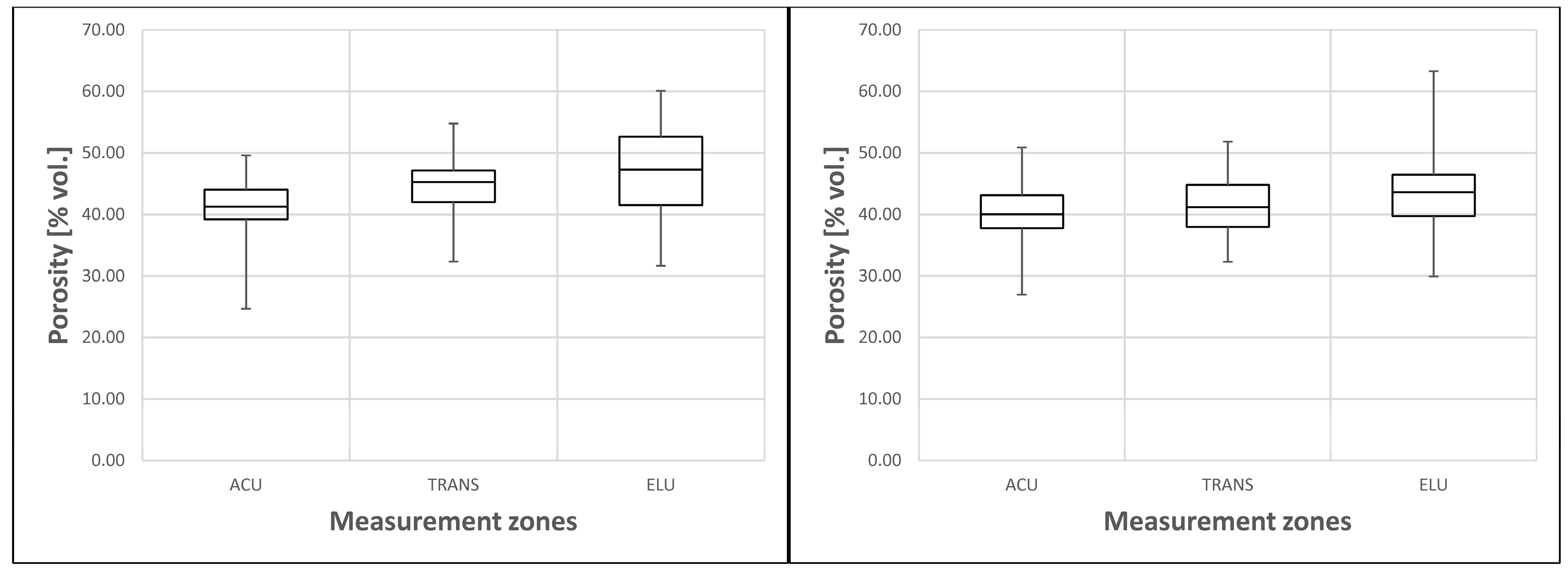

| ACU | TRANS | ELU | |
|---|---|---|---|
| Minimum | 0.00 | 0.00 | 0.00 |
| 25th Percentile | 0.95 | 2.02 | 7.38 |
| Median | 4.11 | 8.31 | 15.35 |
| 75th Percentile | 8.80 | 14.01 | 36.00 |
| Maximum | 41.99 | 96.55 | 284.36 |
| Ks | ρd 10 | P 10 | A 10 | ||
|---|---|---|---|---|---|
| ELU | Ks | 1 | |||
| ρd 10 | −0.530 | 1 | |||
| P 10 | 0.511 | −0.932 | 1 | ||
| A 10 | 0.177 | −0.360 | 0.437 | 1 | |
| TRANS | Ks | 1 | |||
| ρd 10 | −0.386 | 1 | |||
| P 10 | 0.251 | −0.867 | 1 | ||
| A 10 | −0.235 | −0.399 | 0.297 | 1 | |
| ACU | Ks | 1 | |||
| ρd 10 | −0.101 | 1 | |||
| P 10 | 0.111 | −0.667 | 1 | ||
| A 10 | −0.118 | −0.112 | 0.277 | 1 |
| Ks | ρd 30 | P 30 | A 30 | ||
|---|---|---|---|---|---|
| ELU | Ks | 1 | |||
| ρd 30 | 0.073 | 1 | |||
| P 30 | 0.080 | −0.818 | 1 | ||
| A 30 | −0.258 | −0.618 | 0.573 | 1 | |
| TRANS | Ks | 1 | |||
| ρd 30 | −0.019 | 1 | |||
| P 30 | −0.025 | −0.704 | 1 | ||
| A 30 | −0.347 | −0.001 | 0.193 | 1 | |
| ACU | Ks | 1 | |||
| ρd 30 | −0.103 | 1 | |||
| P 30 | 0.145 | −0.698 | 1 | ||
| A 30 | −0.053 | −0.022 | 0.238 | 1 |
Publisher’s Note: MDPI stays neutral with regard to jurisdictional claims in published maps and institutional affiliations. |
© 2022 by the authors. Licensee MDPI, Basel, Switzerland. This article is an open access article distributed under the terms and conditions of the Creative Commons Attribution (CC BY) license (https://creativecommons.org/licenses/by/4.0/).
Share and Cite
Podhrazska, J.; Kucera, J.; Szturc, J.; Blecha, M.; Karasek, P.; Pelisek, I.; Konecna, J. The Effects of Long-Acting Water Erosion on the Hydro-Pedological Characteristics of Chernozems. Agronomy 2022, 12, 2574. https://doi.org/10.3390/agronomy12102574
Podhrazska J, Kucera J, Szturc J, Blecha M, Karasek P, Pelisek I, Konecna J. The Effects of Long-Acting Water Erosion on the Hydro-Pedological Characteristics of Chernozems. Agronomy. 2022; 12(10):2574. https://doi.org/10.3390/agronomy12102574
Chicago/Turabian StylePodhrazska, Jana, Josef Kucera, Jan Szturc, Martin Blecha, Petr Karasek, Igor Pelisek, and Jana Konecna. 2022. "The Effects of Long-Acting Water Erosion on the Hydro-Pedological Characteristics of Chernozems" Agronomy 12, no. 10: 2574. https://doi.org/10.3390/agronomy12102574
APA StylePodhrazska, J., Kucera, J., Szturc, J., Blecha, M., Karasek, P., Pelisek, I., & Konecna, J. (2022). The Effects of Long-Acting Water Erosion on the Hydro-Pedological Characteristics of Chernozems. Agronomy, 12(10), 2574. https://doi.org/10.3390/agronomy12102574






